Peculiarities of Fatigue Crack Growth in Steel 17H1S after Long-Term Operations on a Gas Pipeline
Abstract
:1. Introduction
2. Materials and Methods
3. Results
3.1. Metallographic Studies
3.2. Mechanical Properties of 17H1S Steel Estimated under Tension and Impact
3.3. The Results of the FCG Resistance Test of 17H1S Steel
3.4. Microfractographic Analysis of Damage Features of 17H1S Gas Pipeline Steel after LTO
4. Conclusions
Author Contributions
Funding
Institutional Review Board Statement
Informed Consent Statement
Data Availability Statement
Conflicts of Interest
References
- Ohaeri, E.; Eduok, U.; Szpunar, J. Hydrogen related degradation in pipeline steel: A review. Int. J. Hydrog. Energy 2018, 43, 14584–14617. [Google Scholar] [CrossRef]
- Nykyforchyn, H.M.; Banakhevych Yu, V.; Mytsyk, A.B.; Kostiv, V.V. The role of in-service degradation of gas mains steels in loss of their integrity. Oil Gas Power Eng. 2016, 2, 35–40. [Google Scholar]
- Nykyforchyn, H.; Unigovskyi, L.; Zvirko, O.; Tsyrulnyk, O.; Krechkovska, H. Pipeline durability and integrity issues at hydrogen transport via natural gas distribution network. Procedia Struct. Integr. 2021, 33, 646–651. [Google Scholar] [CrossRef]
- Tsyrulnyk, O.T.; Nykyforchyn, H.M.; Zvirko, O.I.; Petryna, D.Y. Embrittlement of the steel of an oil-trunk pipeline. Mater. Sci. 2004, 2, 302–304. [Google Scholar] [CrossRef]
- Nykyforchyn, H.; Unigovskyi, L.; Zvirko OHredil, M.; Krechkovska, H.; Student, O.; Tsyrulnyk, O. Susceptibility of carbon pipeline steels operated in natural gas distribution network to hydrogen-induced cracking. Procedia Struct. Integr. 2022, 36, 306–312. [Google Scholar] [CrossRef]
- Gredil, M.I. Operating degradation of gas-main pipeline steels. Metallofiz. Noveishie Tekhnol. 2008, 30, 397–406. [Google Scholar]
- Zvirko, O.I.; Kryzhanivskyi, E.I.; Nykyforchyn, H.M.; Krechkovska, H.V. Methods for the evaluation of corrosion-hydrogen degradation of steels of oil-and-gas pipelines. Mater. Sci. 2021, 56, 585–592. [Google Scholar] [CrossRef]
- Krechkovska, H.; Kulyk, V.; Vira, V.; Student, O. Influence of long-term operation of the 17H1S steel on the main gas pipeline on the change of the mechanical properties. Procedia Struct. Integr. 2022, 36, 334–341. [Google Scholar] [CrossRef]
- Krechkovs’ka, H.V.; Tsyrul’nyk, O.T.; Student, O.Z. In-service degradation of mechanical characteristics of pipe steels in gas mains. Strength Mater. 2019, 51, 406–417. [Google Scholar] [CrossRef]
- Nykyforchyn, H.; Tsyrulnyk, O.; Zvirko, O.; Krechkovska, H. Non-destructive evaluation of brittle fracture resistance of operated gas pipeline steel using electrochemical fracture surface analysis. Eng. Fail. Anal. 2019, 104, 617–625. [Google Scholar] [CrossRef]
- Hredil, M.; Krechkovska, H.; Student, O.; Tsyrulnyk, O. Brittle fracture manifestation in gas pipeline steels after long term operation. Procedia Struct. Integr. 2020, 28, 1204–1211. [Google Scholar] [CrossRef]
- Kryzhanivs’kyi, E.I.; Nykyforchyn, H.M. Specific features of hydrogen-induced corrosion degradation of steels of gas and oil pipelines and oil storage reservoirs. Mater. Sci. 2011, 47, 127–136. [Google Scholar] [CrossRef]
- Nykyforchyn, H.; Krechkovska, H.; Student, O.; Zvirko, O. Feature of stress corrosion cracking of degraded gas pipeline steels. Procedia Struct. Integr. 2019, 16, 153–160. [Google Scholar] [CrossRef]
- Zvirko, O.; Zagórski, A. Corrosion and electrochemical properties of the steel of exploited oil tanks in bottom water. Mater. Sci. 2008, 44, 126–132. [Google Scholar] [CrossRef]
- Slobodyan, Z.V.; Nykyforchyn, H.M.; Petrushchak, O.I. Corrosion resistance of pipe steel in oil-water media. Mater. Sci. 2002, 38, 424–429. [Google Scholar] [CrossRef]
- Hredil, M.; Tsyrulnyk, O. Inner corrosion as a factor of in-bulk steel degradation of transit gas pipelines. In Proceedings of the 18th European Conference on Fracture: Fracture of Materials and Structures from Micro to Macro Scale, Dresden, Germany, 29 August–3 September 2010; Volume 483. [Google Scholar]
- Tsyrulnyk, O.T.; Slobodyan, Z.V.; Zvirko, O.I.; Hredil’, M.I.; Nykyforchyn, H.M.; Gabetta, G. Influence of operation of Kh52 steel on corrosion processes in a model solution of gas condensate. Mater. Sci. 2008, 5, 619–629. [Google Scholar] [CrossRef]
- Zvirko, O.I.; Savula, S.F.; Tsependa, V.M.; Gabetta, G.; Nykyforchyn, H.M. Stress corrosion cracking of gas pipeline steels of different strength. Procedia Struct. Integr. 2016, 2, 509–516. [Google Scholar] [CrossRef] [Green Version]
- Ostash, O.P.; Chepil, R.V.; Vira, V.V. The assessment of fatigue life of notched components at uniaxial pulsating loading using the fracture mechanics approach. Int. J. Fatigue 2017, 105, 305–311. [Google Scholar] [CrossRef]
- Nyrkova, L.I. The influence of external and internal factors on stress corrosion cracking of low-alloyed pipe steel. JHPE 2020, 7, 8–15. [Google Scholar] [CrossRef]
- Nykyforchyn, H.M.; Student, O.Z. Influence of hydrogen of the formation of fatigue thresholds in structural steels. Mater. Sci. 2001, 37, 252–263. [Google Scholar] [CrossRef]
- He, J.-C.; Zhu, S.-P.; Luo, C.; Niu, X.; Wang, Q. Size effect in fatigue modelling of defective materials: Application of the calibrated weakest-link theory. Int. J. Fatigue 2022, 165, 107213. [Google Scholar] [CrossRef]
- Li, X.-K.; Zhu, S.-P.; Liao, D.; Correia, J.A.F.O.; Berto, F.; Wang, Q. Probabilistic fatigue modelling of metallic materials under notch and size effect using the weakest link theory. Int. J. Fatigue 2022, 159, 106788. [Google Scholar] [CrossRef]
- Long, X.; Guo, Y.; Su, Y.; Siow, K.S.; Chen, C. Unveiling the damage evolution of SAC305 during fatigue by entropy generation. IJMS 2023, 244, 108087. [Google Scholar] [CrossRef]
- Makovey, V.O. The Problem of Limiting the Destruction of the Main Gas Pipeline; Bulletin of the National Technical University of Ukraine No. 58; Kyiv Polytechnic Institute: Kyiv, Ukraine, 2010; pp. 301–309. (In Ukrainian) [Google Scholar]
- Joo, M.S.; Suh, D.-W.; Bhadeshia, H.K.D.H. Mechanical anisotropy in steels for pipelines. ISIJ Int. 2013, 53, 1305–1314. [Google Scholar] [CrossRef] [Green Version]
- Lino, M. Hydrogen-induced blister cracking of linepipe steel. In Hydrogen Degradation of Ferrous Alloys; Oriani, R.A., Hirth, J.P., Smialowski, M., Eds.; Noyes Publications: Park Ridge, NJ, USA, 1985; pp. 737–762. [Google Scholar]
- Domizzi, G.; Anteri, G.; Ovejero-Garca, J. Influence of sulphur content and inclusion distribution on the hydrogen induced blister cracking in pressure vessel and pipeline steels. Corr. Sci. 2001, 43, 325–339. [Google Scholar] [CrossRef]
- Tsyrul’nyk, O.T.; Nykyforchyn, H.M.; Petryna DYu Hredil, M.I.; Dzioba, I.M. Hydrogen degradation of steels in gas mains after long periods of operation. Mater. Sci. 2007, 43, 708–717. [Google Scholar] [CrossRef]
- Nykyforchyn, H.M.; Kurzydlowski, K.-J.; Lunarska, E. Hydrogen degradation of steels under long-term in-service conditions. In Environment-Induced Cracking of Materials; Shipilov, S.A., Jones, R.H., Olive, J.-M., Rebak, R.B., Eds.; Prediction, Industrial Developments and Evaluations; Elsevier: Amsterdam, The Netherlands, 2008; Volume 2, pp. 349–361. [Google Scholar]
- Nykyforchyn, H.M.; Tsyrul’nyk, O.T.; Petryna, D.Y.; Hredil’, M.I. Degradation of steels used in gas main pipelines during their 40-year operation. Strength Mater. 2009, 41, 501–505. [Google Scholar] [CrossRef]
- Nykyforchyn, H. In-service degradation of pipeline steels. In Degradation Assessment and Failure Prevention of Pipeline Systems; Lecture Notes in Civil Engineering; Bolzon, G., Gabetta, G., Nykyforchyn, H., Eds.; Springer: Cham, Switzerland, 2021; Volume 102, pp. 15–29. [Google Scholar] [CrossRef]
- Nykyforchyn, H.M. Environmentally assisted degradation of the physical and mechanical properties of long-term exploited structural steels. ESIS Newslett. 2013, 52, 20–24. [Google Scholar]
- Student, O.Z.; Krechkovs’ka, H.V. Anisotropy of the mechanical properties of degraded 15Kh1M1F steel after its operation in steam pipelines of thermal power plants. Mater. Sci. 2012, 47, 590–597. [Google Scholar] [CrossRef]
- Krechkovs’ka, H.V.; Student, O.Z.; Nykyforchyn, H.M. Diagnostics of the engineering state of steam pipeline of thermal power plants by the hardness and crack resistance of steel. Mater. Sci. 2019, 54, 627–637. [Google Scholar] [CrossRef]
- Filippov, G.A.; Livanova, O.V.; Chevskaya, O.N.; Shabalov, I.P. Pipe steel degradation during operation and brittle failure resistance. Metallurgist 2013, 57, 612–622. [Google Scholar] [CrossRef]
- Maruschak, P.O.; Danyliuk, I.M.; Bishchak, R.T.; Vuherer, T. Low temperature impact toughness of the main gas pipeline steel after long-term degradation. Cent. Eur. J. Eng. 2014, 4, 408–415. [Google Scholar] [CrossRef] [Green Version]
- Okipnyi, I.; Poberezhny, L.; Zapukhlia, V.; Hrytsanchuk, A.; Poberezhna, L.; Stanetsky, A.; Kravchenko, V.; Rybitskyi, I. Impact of long-term operation on the reliability and durability of transit gas pipelines. Stroj. Cas. 2020, 70, 115–126. [Google Scholar] [CrossRef]
- Zurnadzhy, V.I.; Efremenko, V.G.; Petryshynets, I.; Shimizu, K.; Brykov, M.N.; Kushchenko, I.V.; Kudin, V.V. Mechanical properties of carbide-free lower bainite in complex-alloyed constructional steel: Effect of bainitizing treatment parameters. Kov. Mater. 2020, 58, 129–140. [Google Scholar] [CrossRef]
- Krechkovs’ka, H.V.; Student, O.Z.; Kutnyi, A.I.; Nykyforchyn, H.M.; Sydor, P.Y. Brittle-fracture resistance of the metal of hyperboloid gridshell Shukhov tower. Mater. Sci. 2015, 50, 578–584. [Google Scholar] [CrossRef]
- Krechkovska, H.; Hredil, M.; Student, O.; Svirska, L.; Krechkovska, S.; Tsybailo, I.; Solovey, P. Peculiarities of fatigue fracture of high-alloyed heat-resistant steel after its operation in steam turbine rotor blades. Int. J. Fatigue 2023, 167, 107341. [Google Scholar] [CrossRef]
- Nemchuk, O.O.; Krechkovska, H.V. Fractographic substantiation of the loss of resistance to brittle fracture of steel after operation in the marine gantry crane elements. Metallofiz. Noveishie Tekhnol. 2019, 41, 825–836. [Google Scholar] [CrossRef] [Green Version]
- Ostash, O.P.; Andreiko, I.M.; Kulyk, V.V.; Vavrukh, V.I. Influence of braking on the microstructure and mechanical behavior of railroad wheel steels. Mater. Sci. 2013, 48, 569–574. [Google Scholar] [CrossRef]
- Ostash, O.P.; Panasyuk, V.V.; Andreiko, I.M.; Chepil, R.V.; Kulyk, V.V.; Vira, V.V. Methods for the construction of the diagrams of fatigue crack-growth rate of materials. Mater. Sci. 2007, 43, 479–491. [Google Scholar] [CrossRef]
- Krechkovs’ka, H.V.; Student, O.Z. Determination of the degree of degradation of steels of steam pipelines according to their impact toughness on specimens with different geometries of notches. Mater. Sci. 2017, 52, 566–571. [Google Scholar] [CrossRef]
- Rykavets, Z.M.; Bouquerel, J.; Vogt, J.-B.; Duriagina, Z.A.; Kulyk, V.V.; Tepla, T.L.; Bohun, L.I.; Kovbasyuk, T.M. Investigation of the microstructure and properties of trip 800 steel subjected to low-cycle fatigue. Prog. Phys. Met. 2019, 20, 620–633. [Google Scholar] [CrossRef]
- Hredil, M.; Krechkovska, H.; Tsyrulnyk, O.; Student, O. Fatigue crack growth in operated gas pipeline steels. Procedia Struct. Integr. 2020, 26, 409–416. [Google Scholar] [CrossRef]

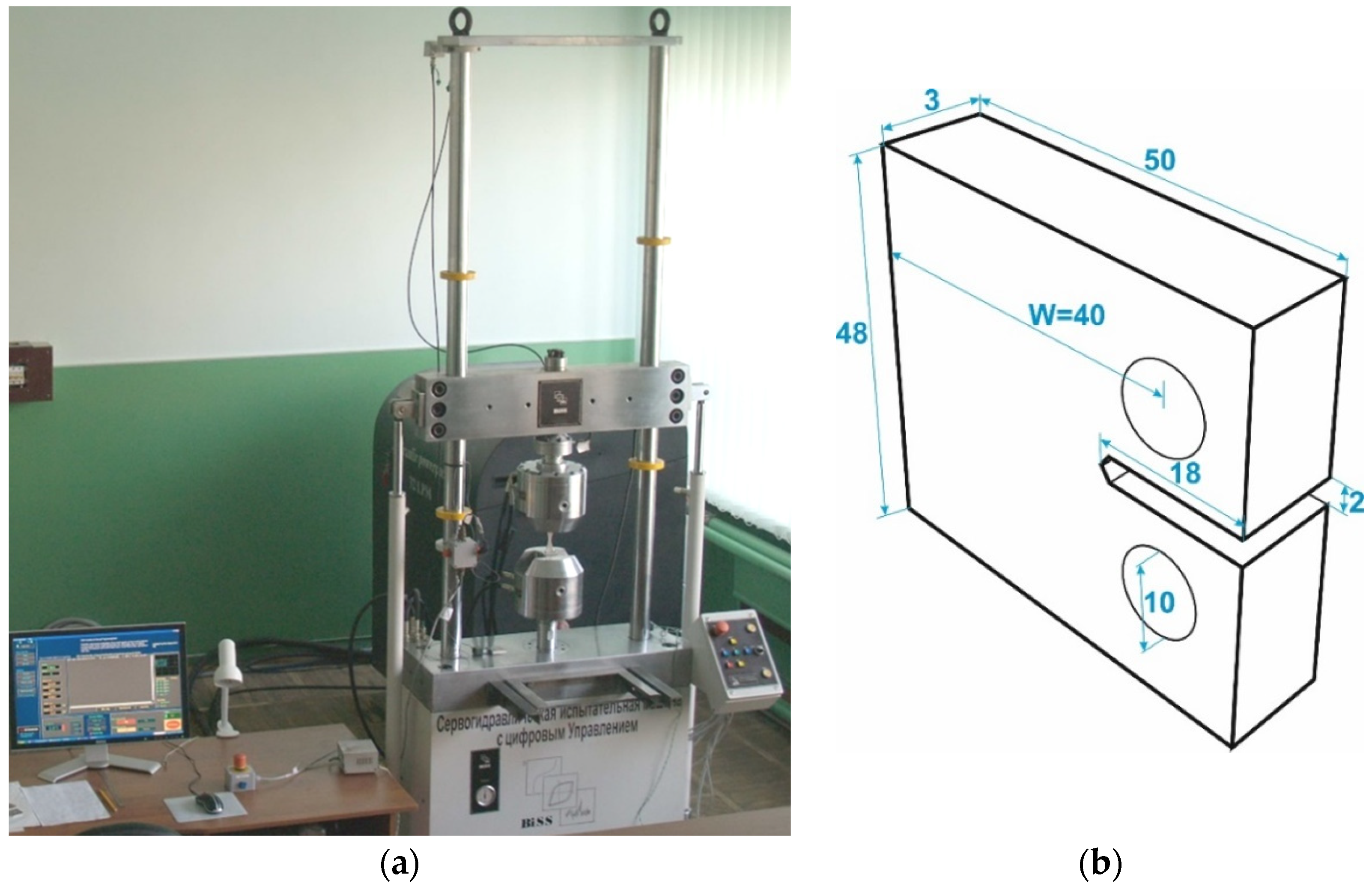



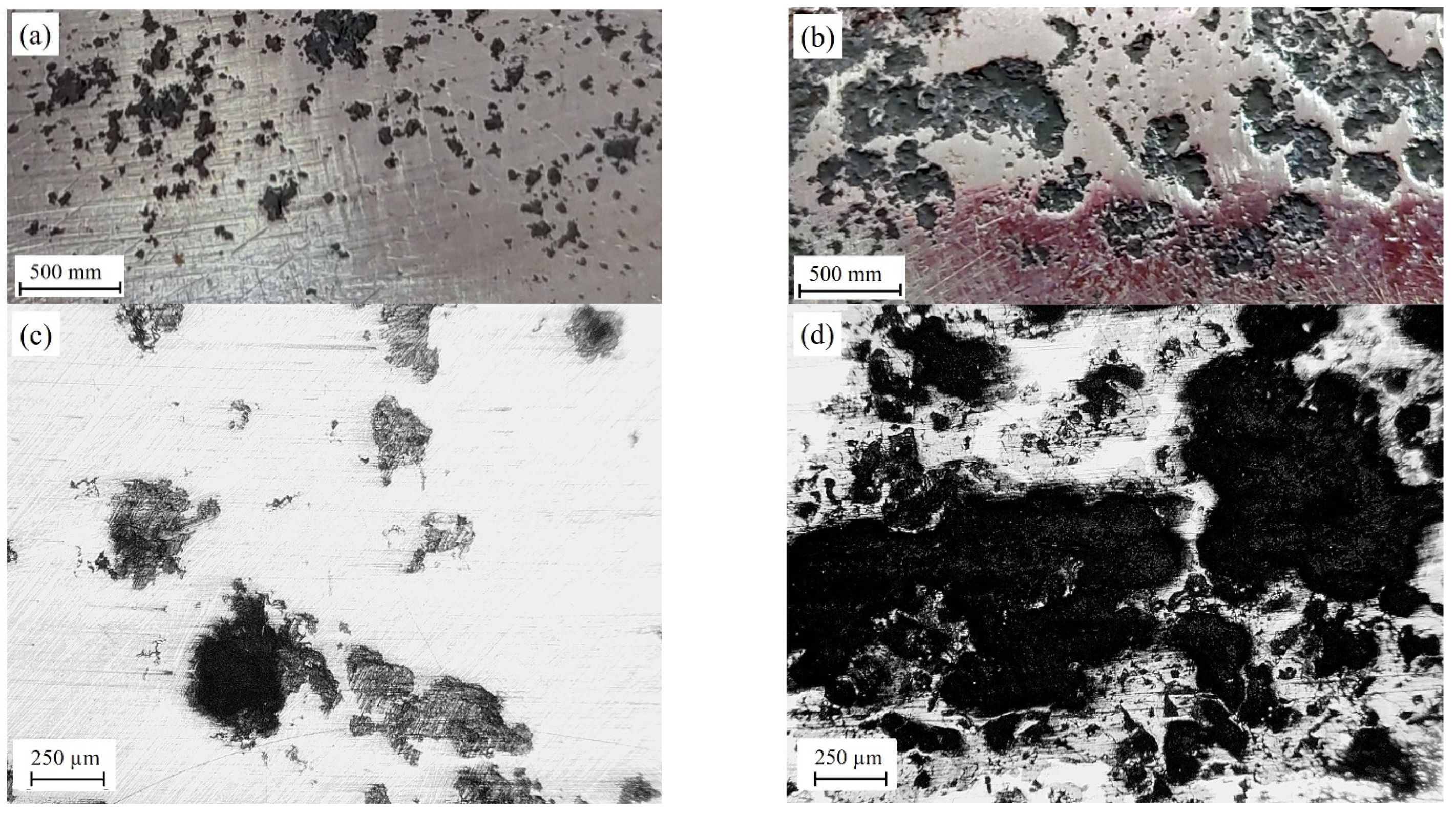
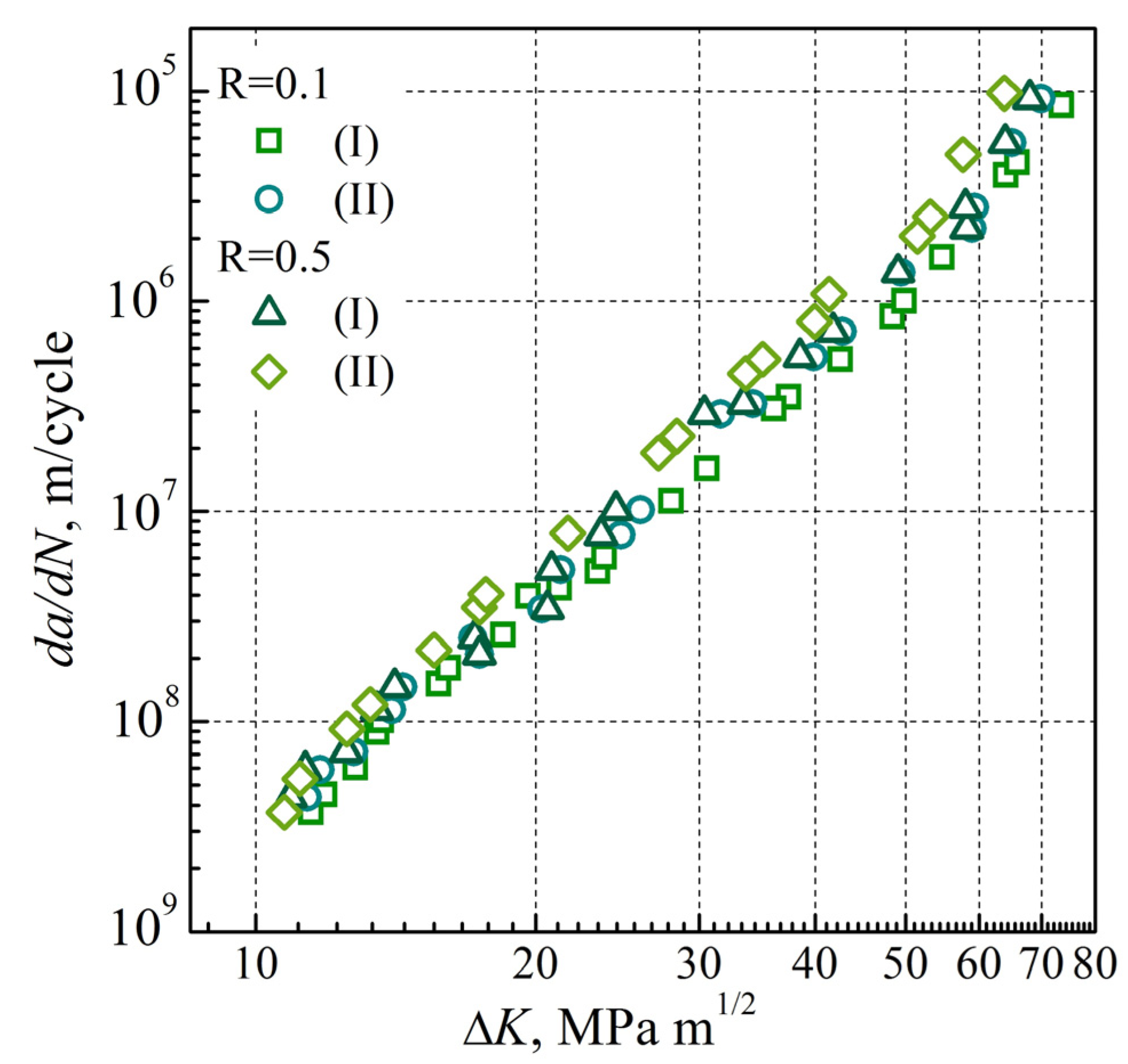
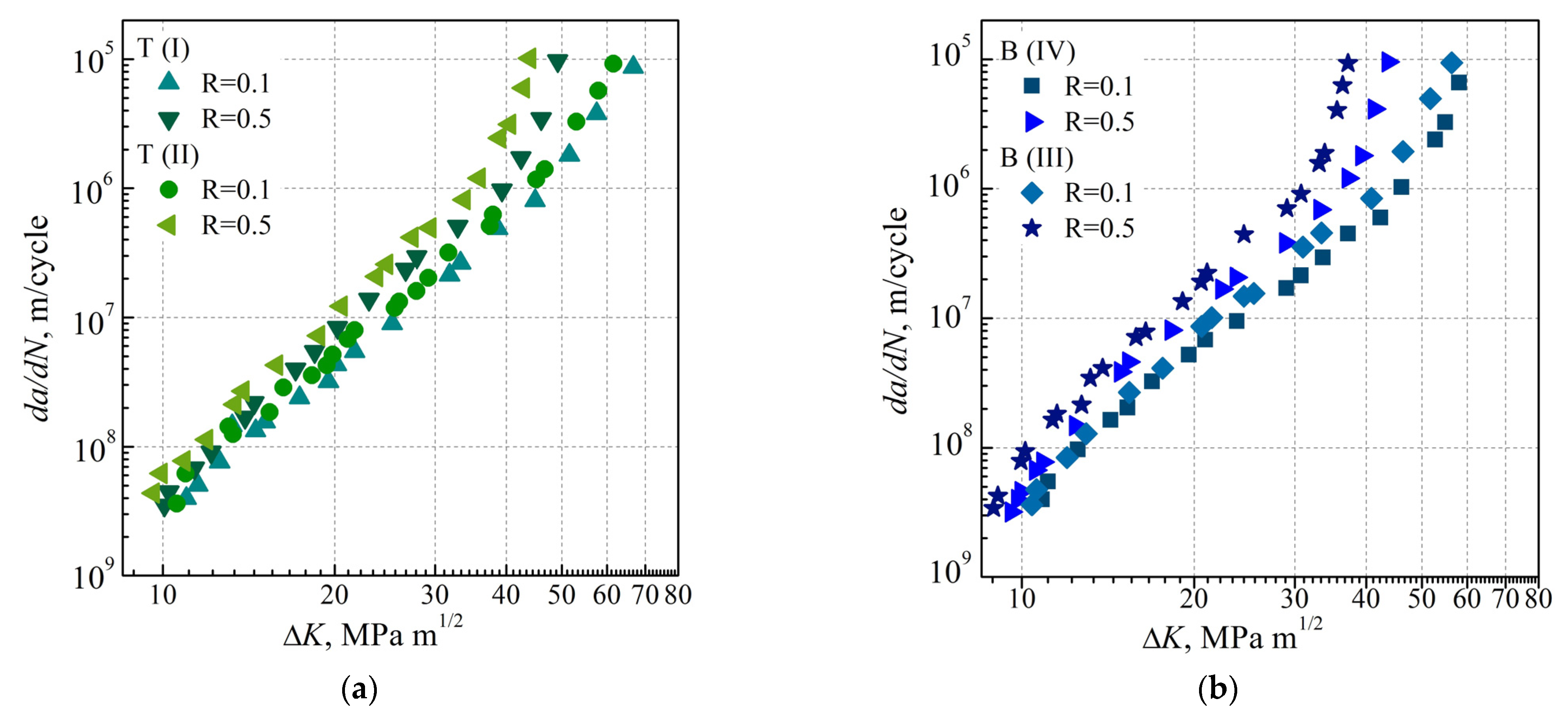
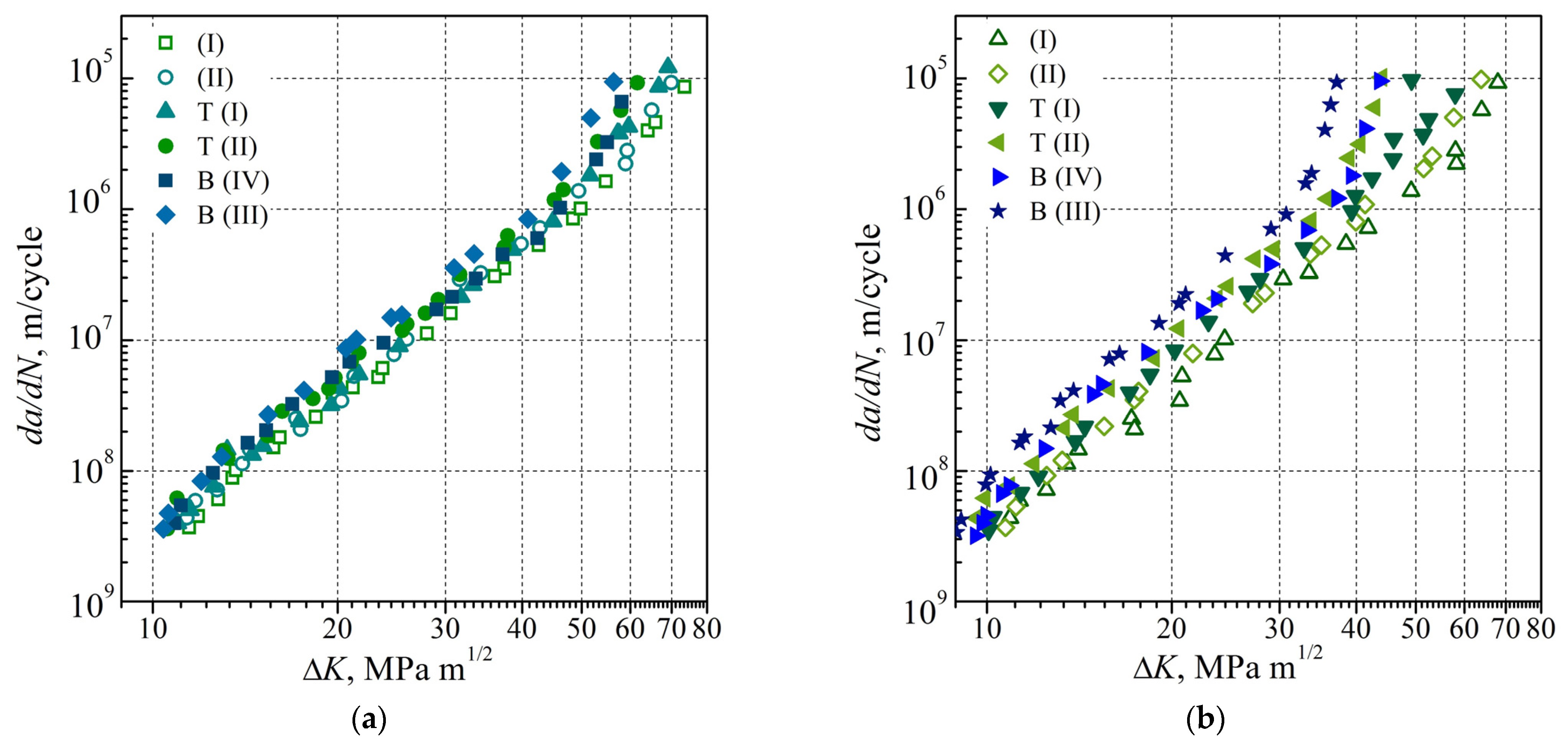
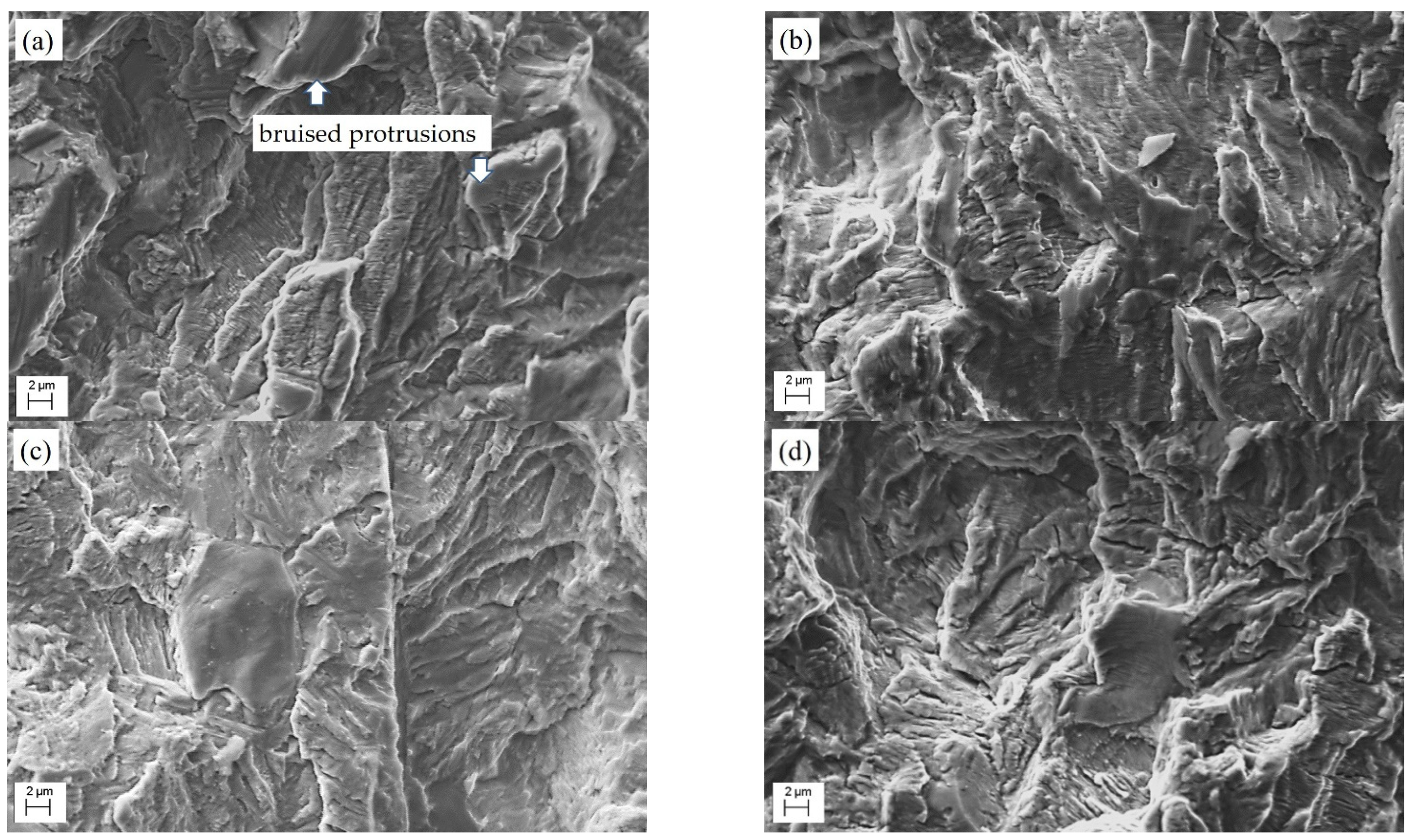
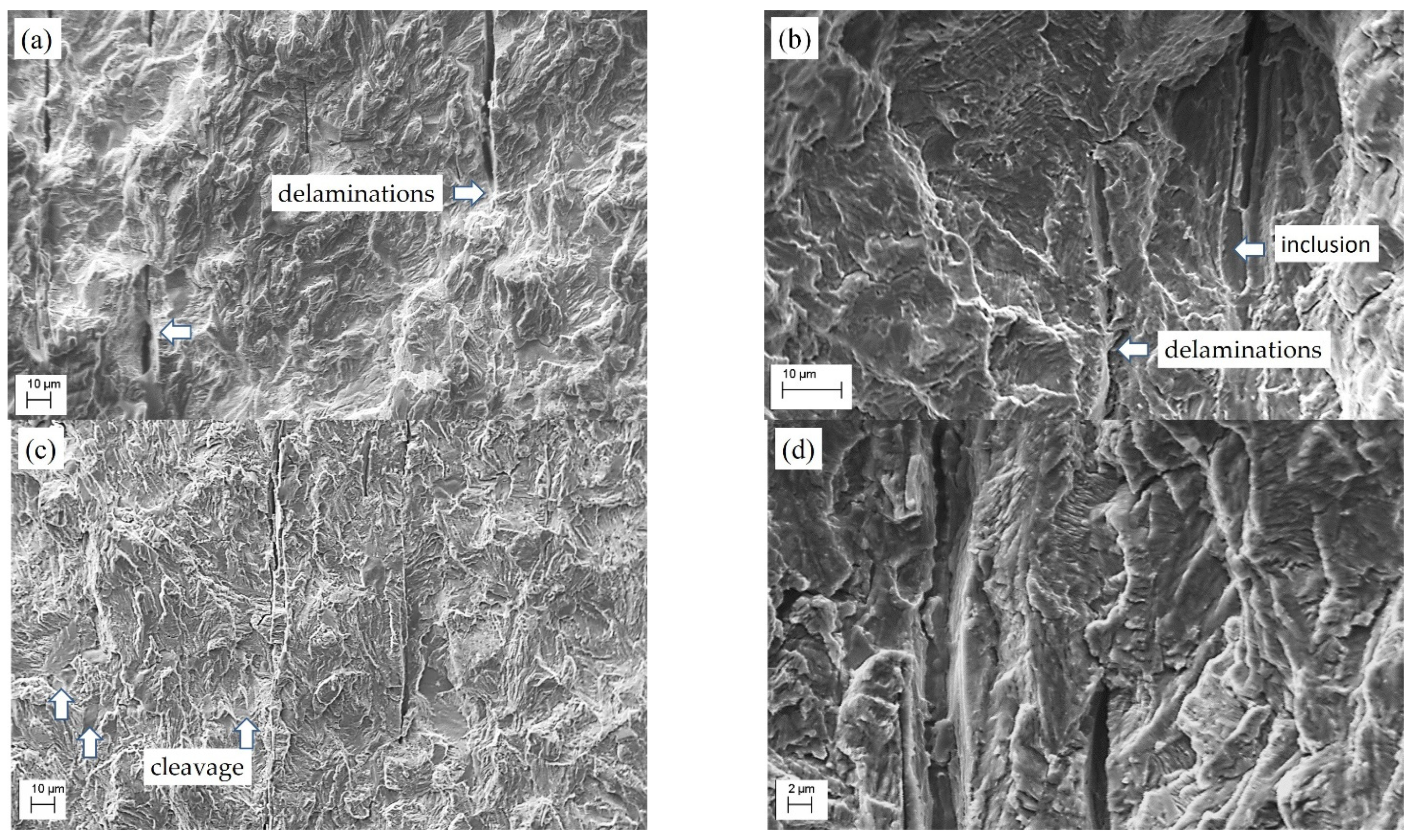


| Condition | Fe | C | Si | Mn | Cr | S | P |
|---|---|---|---|---|---|---|---|
| AR state | Balance | 0.165 | 0.57 | 1.53 | 0.069 | 0.009 | 0.007 |
| After LTO | Balance | 0.171 | 0.47 | 1.25 | 0.028 | 0.0043 | 0.005 |
| Regulated composition | Balance | 0.15–0.2 | 0.4–0.6 | 1.15–1.6 | <0.3 | ≤0.4 | ≤0.35 |
| Condition | Pipe Part (Marking) | Surface (Marking) | σUTS, MPa | σYS, MPa | Elongation at Break, % | KCV, MJ/m2 |
|---|---|---|---|---|---|---|
| AR | - | Outer (I) | 558 | 378 | 29.4 | 0.54 |
| Inner (II) | 560 | 423 | 26.7 | 0.56 | ||
| After LTO | Upper (T) | Outer (I) | 500 | 291 | 28.6 | 0.36 |
| Lower (B) | Outer (IV) | 545 | 325 | 27.6 | - | |
| Upper (T) | Inner (II) | 545 | 355 | 26.7 | 0.4 | |
| Lower (B) | Inner (III) | 544 | 351 | 26.7 | 0.32 |
Disclaimer/Publisher’s Note: The statements, opinions and data contained in all publications are solely those of the individual author(s) and contributor(s) and not of MDPI and/or the editor(s). MDPI and/or the editor(s) disclaim responsibility for any injury to people or property resulting from any ideas, methods, instructions or products referred to in the content. |
© 2023 by the authors. Licensee MDPI, Basel, Switzerland. This article is an open access article distributed under the terms and conditions of the Creative Commons Attribution (CC BY) license (https://creativecommons.org/licenses/by/4.0/).
Share and Cite
Vira, V.; Krechkovska, H.; Kulyk, V.; Duriagina, Z.; Student, O.; Vasyliv, B.; Cherkes, V.; Loskutova, T. Peculiarities of Fatigue Crack Growth in Steel 17H1S after Long-Term Operations on a Gas Pipeline. Materials 2023, 16, 2964. https://doi.org/10.3390/ma16082964
Vira V, Krechkovska H, Kulyk V, Duriagina Z, Student O, Vasyliv B, Cherkes V, Loskutova T. Peculiarities of Fatigue Crack Growth in Steel 17H1S after Long-Term Operations on a Gas Pipeline. Materials. 2023; 16(8):2964. https://doi.org/10.3390/ma16082964
Chicago/Turabian StyleVira, Volodymyr, Halyna Krechkovska, Volodymyr Kulyk, Zoia Duriagina, Oleksandra Student, Bogdan Vasyliv, Veronika Cherkes, and Tetiana Loskutova. 2023. "Peculiarities of Fatigue Crack Growth in Steel 17H1S after Long-Term Operations on a Gas Pipeline" Materials 16, no. 8: 2964. https://doi.org/10.3390/ma16082964








